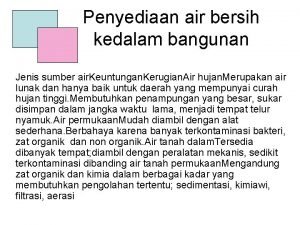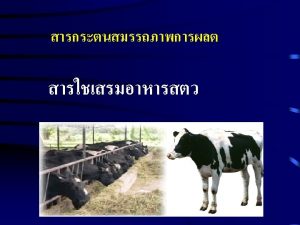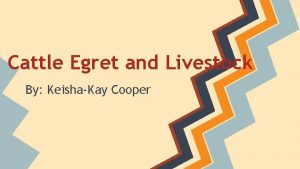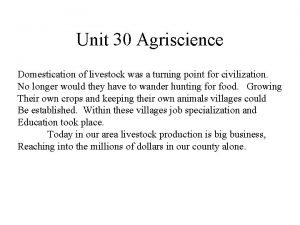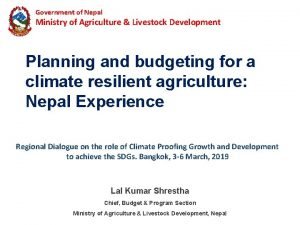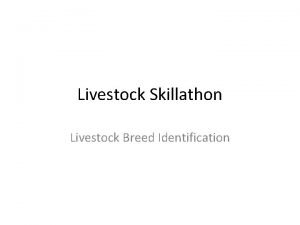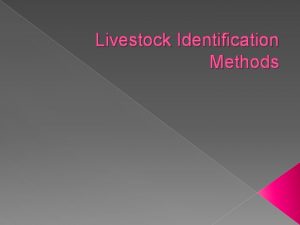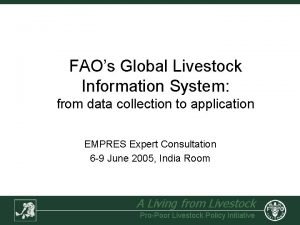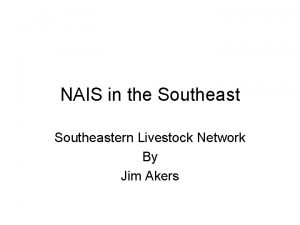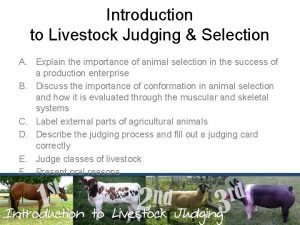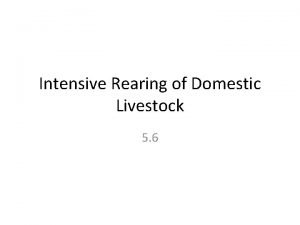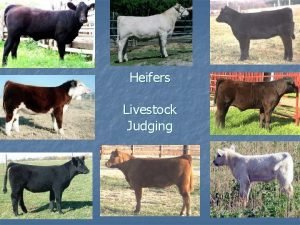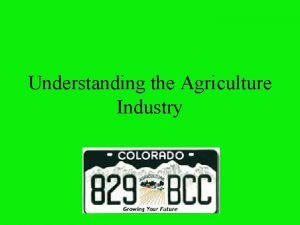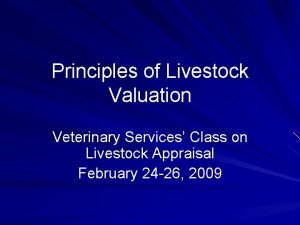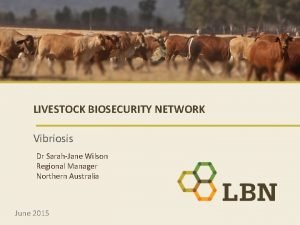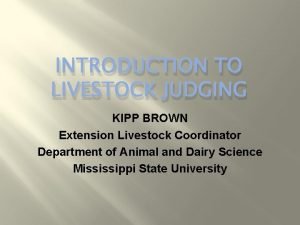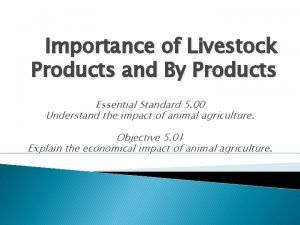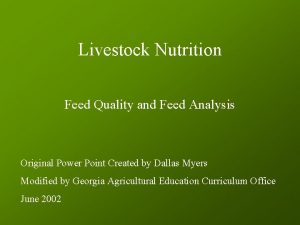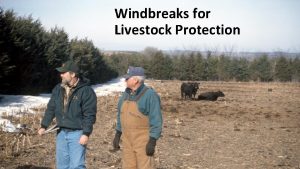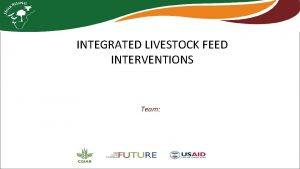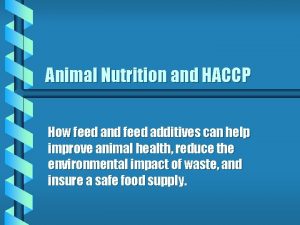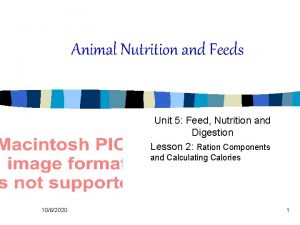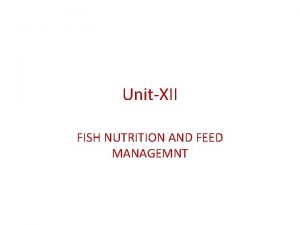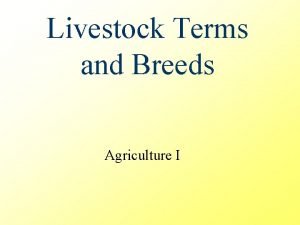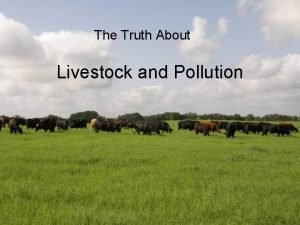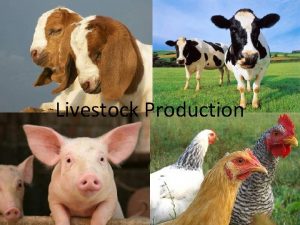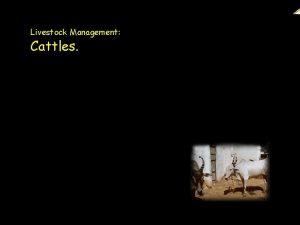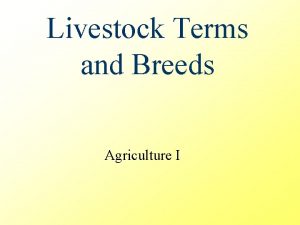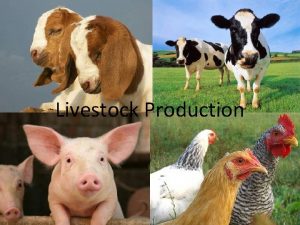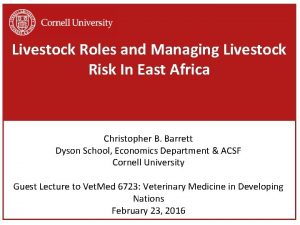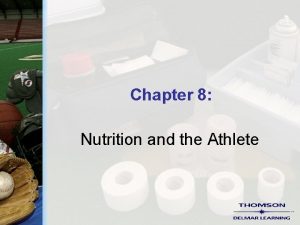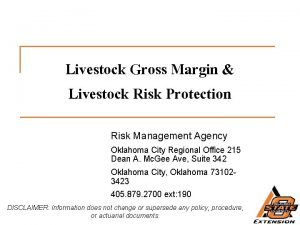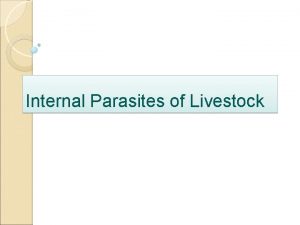Livestock Nutrition Chapter 8 Feed Quality and Feed



























- Slides: 27

Livestock Nutrition Chapter 8 Feed Quality and Feed Analysis

Objectives • Describe quality Characteristics of grains and other feeds. • Describe methods of harvesting quality hay and silage. • Describe the analysis of feedstuffs. • Describe methods of measuring the value of feeds. • Describe regulations relating to the manufacture and sale of feed stuffs.

Feed Quality • Quality of feed affects its value for animal nutrition. • Quality factors include palatability and nutrient content. • Improper harvesting or handling will reduce quality. • Palatability refers to how well the animal will accept feed.

Feed Quality • If an animal does not find a feed palatable it will not eat enough, make good gains, grow properly or produce meat, milk or eggs. • Feeds on produced on well fertilized soils will produce feed, especially roughages, that is of a higher quality. • Vitamins, amino acid content and minerals will also be affected by soil type.

Harvesting Hay for Quality • Quality of hay is affected by harvesting and handling methods. • Stemmy hay with fewer leaves is of lower quality, because the leaves contain the most nutrients and are the easiest digest. • Shattering is the loss of leaves due to harvesting and handling.

Harvesting Hay for Quality • Legume hays will shatter easier than grass hays. • Moisture content of hay must be reduced so it can be stored without spoiling or serious loss of nutrients. • Field forages must not contain more than 18 -22% moisture for baling. • Factors affecting moisture content include, humidity and movement of air, fineness of forage and how compact the bale is.

Harvesting Quality Hay • Shattering, leaching and bleaching are 3 things that cause loss of quality during harvesting. • When forages get too dry, leaves tend to shatter. • Forage that is rained on while curing will suffer loss of quality by leaching, (loss of water soluble nutrients. • Bleaching occurs when the forage has cured to long in extremely hot temperatures.

Harvesting Quality Hay • Forages should be cut as soon as possible after reaching the early bloom stage of maturity. • If hay is not conditioned it will require two days of drying before it is ready to bale. • Conditioning breaks the stems, reducing the amount of time that it takes dry the hay.

Harvesting Quality Hay • Hay should be baled as soon as possible after it reaches a safe moisture level for storage. • Delays in baling at this point will increase the chances of losing nutrients to bleaching and leaching. • If small square bales are not stored under cover they will lose quality due to moisture, causing musty and moldy bales. • Rain and snow can easily soak a small bale stack through and through

Producing Quality Silage • When high moisture crops are stored under anaerobic, without air, conditions, a fermentation process occurs that produces silage. • Crops may be stored is vertical or horizontal silos. • Vertical silos require less land, less spoilage and require less labor for unloading.

Vertical Silos • Can be either conventional or gas tight. • Conventional are constructed of concrete staves, metal, or cast in place concrete. • At time of ensiling crop should contain 2535% moisture. • If crop is to high or low in moisture, spoilage will be high. • Gas tight silos are constructed to eliminate air, ensure preservation and storage of forages with a range of approximately 2575% moisture.

Horizontal Silos • Trench, bunker and stack are three types of horizontal silos. • A trench silo is usually dug into the side of a hill, a concrete bottom is recommended due to mud and water. • Filling is accomplished with dump trucks or wagons. • After filling the pit is covered with a polyethylene sheet and weighted with dirt, concrete blocks or boards.

Horizontal Silos • Bunker silos are posts and boards with a side lining of building paper or plastic. • Bunker silos are above ground, while pit or trench silos are below ground. • Bunkers silos are usually made with a concrete floor as well.

Horizontal Silos • Stack silos require a small investment and may be used for emergency storage of surplus silage. • Silage is spread in shallow layers using tractors, the sides should slope 60 degrees. • During filling the silage is packed with a tractor. • When filling is completed, the top of the stack is rounded off, black plastic 4 -6 mil thick, is used to cover the stack. • The slack should be always taken out of the plastic with the weights on the side.

Physiological Changes in Silo • The most commonly used silages are corn and sorghum. • Crop should be at 62 -68% moisture before ensiling. • If crop is too wet it will not produce lactic acid butyric acid, causing a sour feed with high nutrient loss. • If it is too dry it will mold easily.

Physiological changes • It takes about 21 days for the fermentation process to complete. • Living cells continue to burn plant sugars, use oxygen, and give off carbon dioxide, water and heat. • Acetic acid is produced early in the process and plant p. H changes from 6. 0 to 4. 2. • After 3 days, the formation of acetic acid slows down and lactic acid is formed.

Physiological changes • Formation of lactic acid continues for about another 2 weeks and the temp decreases. • Bacterial action stops when p. H reaches 4. • If conditions are have been right, the silage is now fairly stable, and will remain so for a long period of time. • The ideal temp is 80 -100 degrees, if temp is lower butyric acid is formed, causing foul odor and breaking down the protein. • Higher temps cause caramelized silage is formed, it is sweet tobacco smelling, it is higher is palatability but low in nutrient value

Harvesting Crops for Silage • Corn should be harvested at the dough to hard dent stage, 32 -38% moisture. • Grasses and legumes should be wilted to below 65% moisture. • Grasses should be ensiled in the early heading stage and legumes at about one tenth bloom. • Small grains are harvested for silage in the boot to early milk stage for best results.

Silages • Grass and Legumes should be chopped at one quarter inch. • Dry matter losses are kept to a minimum when grasses and legumes are stored in the silo at 50 -65%.

Adding Dry Matter and Preservatives • Many things are added to silages to reduce moisture, aid in curing and increase palatability. • Dry grain, is added to reduce moisture, however it may not be economically feasible. • Chemicals increase palatability but also may not be financially feasible.

Important other Factors • Rapid filling, even distribution, packing and prompt covering of silages. • Legumes that are higher in protein will spoil quicker. • Grass silage does not keep well in trench or bunker silos. • Corn silage should be chopped to 1/4 -3/8 of an inch. • Corn should be filled quickly and evenly.

Feed Samples for Analysis • Sample must be carefully secured to accurately represent a much larger quantity of feed. • Less than one quart of feed is usually submitted. • There are many was to sample, hand, harvest, core and bulk feed. Moisture content should always be consistent as possible.

Proximate Analysis of Feedstuffs • Feed using chemical and mechanical means is separated into 6 components. • Water content, crude protein with Kjeldahl process, crude fat, crude fiber, minerals, and Nitrogen free extract.

Limitation of Proximate • No indication of palatability, digestibility, toxicity or nutritional value. • Feeding trials with live animals are necessary to determine actual worth of a feed for practical feeding purposes. • Organic components of the feed, crude proteins, amino acids, ether extract and cell wall may vary in individual fees as much as 15% more or less than the table values.

Feed Composition Basis • All feeds contain moisture, depending upon the form fed, time harvested and storage time. • As fed means the data is calculated on the basis of the average amount of moisture found in the feed as it is used on the ranch. • 100% dry matter basis means that the data presented is calculated on the basis of all the moisture removed from the feed.

Van Soest Method • Neutral detergent soluble is lipids, sugars, starches and proteins. • Neutral detergent fiber is the more insoluble material found in the cell wall. • Consists of cellulose, lignin, silica, hemicellulose and some protein. • Acid detergent fiber consists of cellulose, lignin and some silica.

 Feed up feed forward feedback
Feed up feed forward feedback Beate sitek
Beate sitek Perbedaan feed additive dan feed supplement
Perbedaan feed additive dan feed supplement Sistem up feed
Sistem up feed Feed additive dan feed supplement
Feed additive dan feed supplement Cattle egrets and livestock
Cattle egrets and livestock Unit 30 agriscience
Unit 30 agriscience Ministry of agriculture and livestock development
Ministry of agriculture and livestock development Perform quality assurance
Perform quality assurance Concepts of quality control
Concepts of quality control Livestock breed identification swine - assessment
Livestock breed identification swine - assessment Livestock judging transition terms
Livestock judging transition terms Livestock judging powerpoints
Livestock judging powerpoints Livestock risk management brokers near me
Livestock risk management brokers near me Animal kingdom taxonomy chart
Animal kingdom taxonomy chart Livestock identification methods
Livestock identification methods Livestock information system
Livestock information system Parasites of livestock - vocabulary
Parasites of livestock - vocabulary Livestock network
Livestock network Livestock judging card
Livestock judging card Domestic livestock
Domestic livestock Beef cattle judging practice
Beef cattle judging practice Colorado agriculture facts
Colorado agriculture facts Livestock valuation methods
Livestock valuation methods Livestock biosecurity network
Livestock biosecurity network Judging 101
Judging 101 Goat judging terminology
Goat judging terminology Livestock breed identification swine - vocabulary
Livestock breed identification swine - vocabulary



